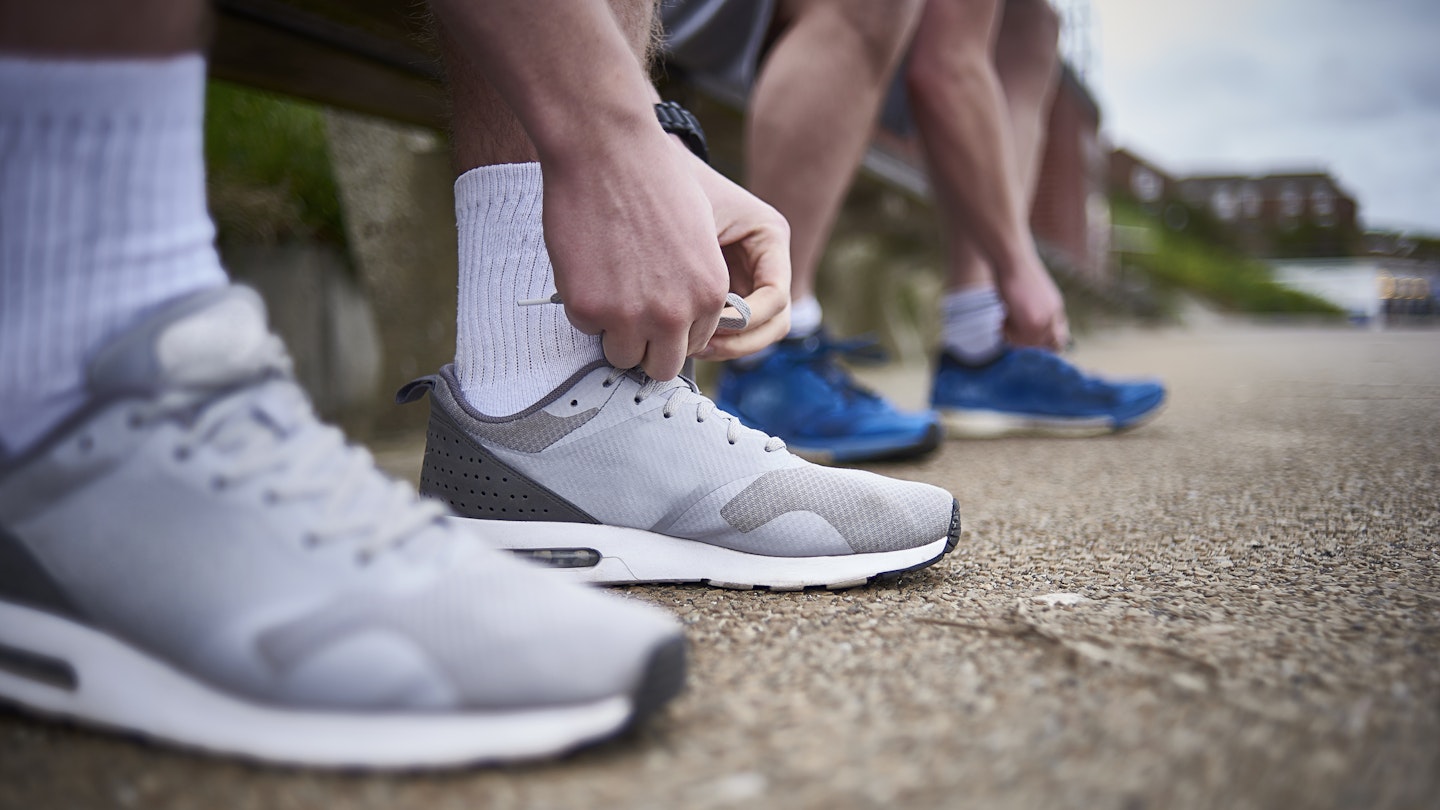With such a huge range of trainers on offer, all claiming to be 'the best running shoes', it can be a bit of a minefield. Cushioning, over-pronation, under-pronation and drop are just a few concepts you’ll need to get comfortable with - which is where we come in.
Start with this, and you won’t go far wrong: when it comes to choosing the best shoes, think about where you are going to run. If it’s on the road or for activities like CrossFit, a nice cushioned shoe is good; off-road and you’ll want something with a little grip. From there, the world is your oyster.
The best running shoes at a glance:
• Best all-round running shoes: Adidas Ultraboost 1.0 - View now on Adidas
• Best running shoes backed by athletes: KIPRUN KD900X - View now on Decathlon
• Best running shoes for block running: PUMA Men's Axelion Block - View now on Amazon
Fit is very personal. However, everybody’s feet expand slightly as the day progresses, so try on shoes in the afternoon. Similarly, your feet will need about a half size extra for long events such as the marathon, as once again, your feet will swell up as the race goes on.
Our top picks: The best running shoes 2023
Best all-round
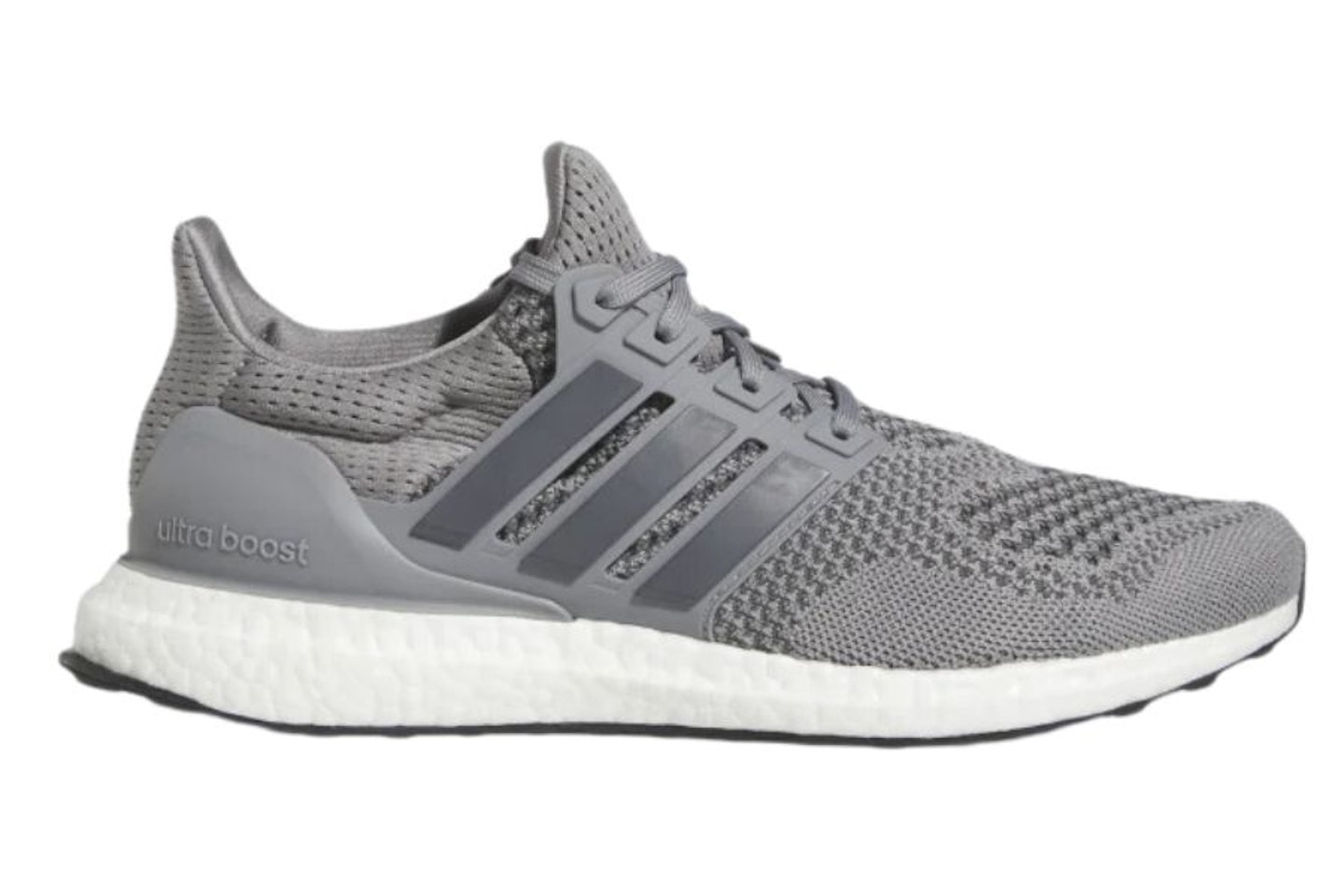
Hit your fitness goal with this cool running shoe. Whether you're looking for something comfortable for races or durable for long distances, this will be proven to be more than just its designer label. What's more, this shoe has been engineered to support you with each stride with its PRIMEKNIT upper and fitcounter moulded heel.
Pros
- Made with Parley Ocean Plastic for the more sustainably-minded fitness enthusiasts
- PRIMEKNIT textile upper to enhance movement
- Stretchweb outsole to stretch with each step
- Great selection of colours available
Cons
- Some users found they had to size up with this trainer
| Sizes: | UK 6-14.5 |
| Colours: | Various colours available including: Taupe, Black, Blue, Red, Grey |
| Men/Women? | Available in both men's and women's |
- Customer review: "Sooo comfy! Ultraboosts are like walking on clouds. I wear these for long alms and have golf Ultraboosts for long days on the course. Easily the comfiest trainers I’ve owned."
Best Adidas
www.adidas.co.uk
The adidas Supernova Primas are the running shoes for the people. These sports shoes have been built from the ground up to tick so many boxes, and they do so wonderfully. You’re getting a dreamy mesh upper which feels breathable without sacrificing durability. Speaking of dreams, adidas features the Dreamstrike+ midsole in these particular running shoes, and it’s an experience to say the least. There’s a level of cushioning that’s neither too bouncy, nor too firm, but just right.
This is a fabulously fitting running shoe. Yes, in true adidas fashion they do run on the small side. So, we’d recommended going about half a size up. Once you’ve found your fit though, you’ll realise how perfectly tuned these shoes are for running. From forefoot to heel, the Supernova Primas provide a truly tailored fit, they’re snug but still beyond comfortable and breathable.
Digital Writer Jack Barrell has worn the Supernova Primas and tested them out on the road for himself. Here's how he found them: "These might be some of adidas’ best running shoes to date. They should be an exceptionally tempting option for the day-to-day runner as well as the seasoned veteran. The fit is unmatched, they’re snug, comfy, but highly responsive in order to offer that competitive edge.
There’s no faulting the visuals either, adidas’ expert craftsmanship has conjured up another brilliant looking sports shoe."
Pros
- A pleasant, universal fit from heel to forefoot
- Near perfect amount of cushioning, not overwhelming nor too firm
- Great build quality
- Super sharp design
Cons
- Unusual tread design
| Sizes: | UK 6-17 |
| Colours: | Solar Red / Carbon / Pulse Lime |
| Men/Women? | Men |
Best for women
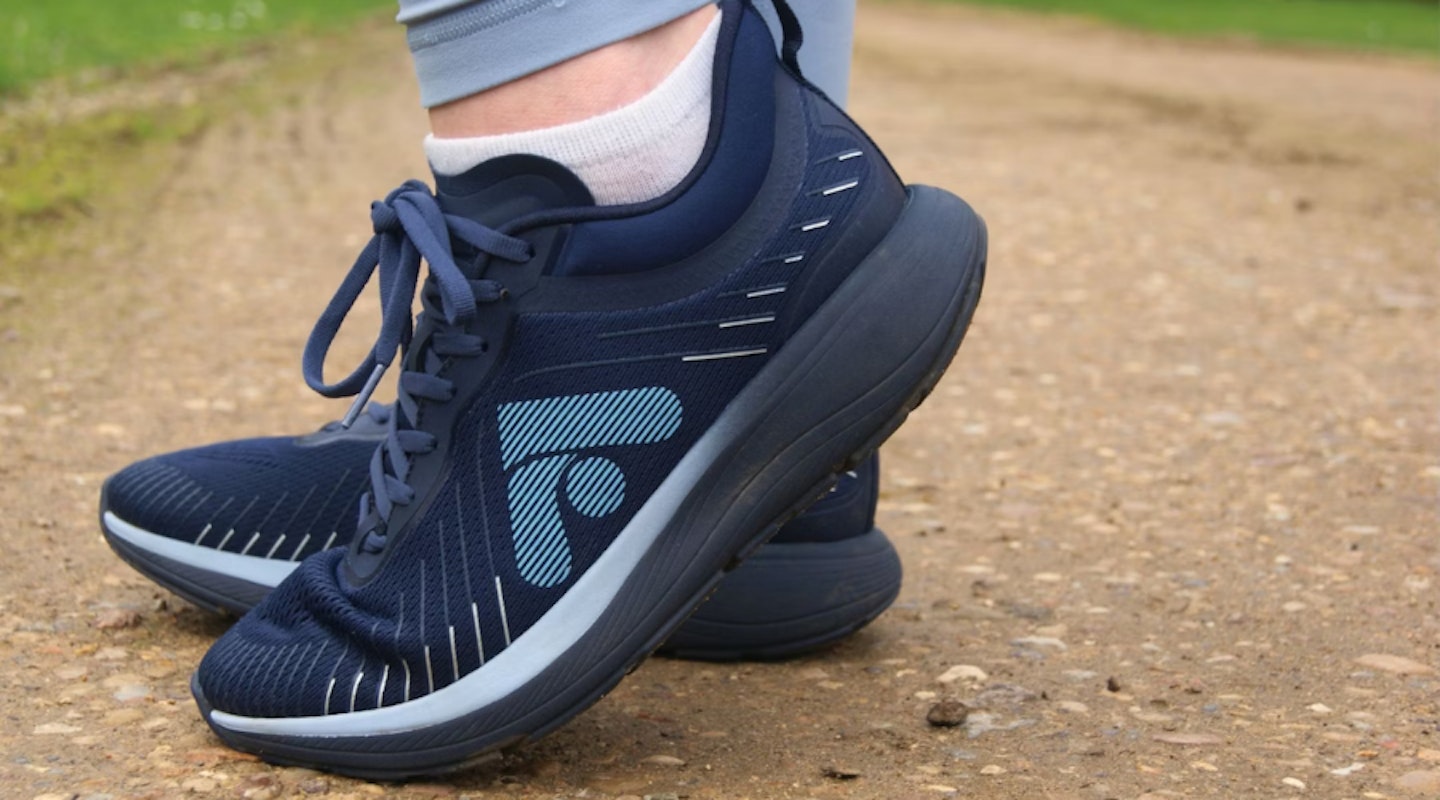 Gemma Lavers - What's the Best
Gemma Lavers - What's the Bestwww.fitflop.com
Recognising that women often have narrower feet, higher arches, and different stride patterns compared to men, these FFRUNNER trainers are engineered to accommodate such distinctions. They offer an anatomically contoured footbed, springy Neodynamic midsole, and excellent breathability through a mesh upper.
While they excel in comfort and performance, making each run feel effortless and supported, the FFRUNNERs do present some drawbacks. The fit can be slightly challenging due to their snug toe box and the need for a bit of effort to slip them on and off. Furthermore, the colour selection is decent but not particularly striking. Despite these minor issues, the overall design and specific features aimed at enhancing female running experiences make these trainers a commendable choice in a market still catching up to the need for gender-specific athletic footwear.
Read our full FitFlop FFRUNNER trainer review
Pros
- Features springy Neodynamic midsole to naturally encourage your foot forward
- Toe spring and heel kick create fluid movement from heel to toe
- Anatomically contoured footbed provides arch support and diffuses pressure
Cons
- Not the easiest to put on and take off
| Sizes: | UK 3-9 |
| Colours: | Navy, White, Black, Grey, Blush, Ombre |
| Men/Women? | Women's |
- Our review: "In a market where truly gender-specific running shoes are a rarity, FitFlop's FFRUNNER trainers lead the way. Despite their slightly challenging fit and an okay colour selection, these trainers stand out for their breathability, support, and for setting the standard in gender-specific footwear." Tried and tested by Health & Fitness Writer Gemma Lavers.
Best for grip
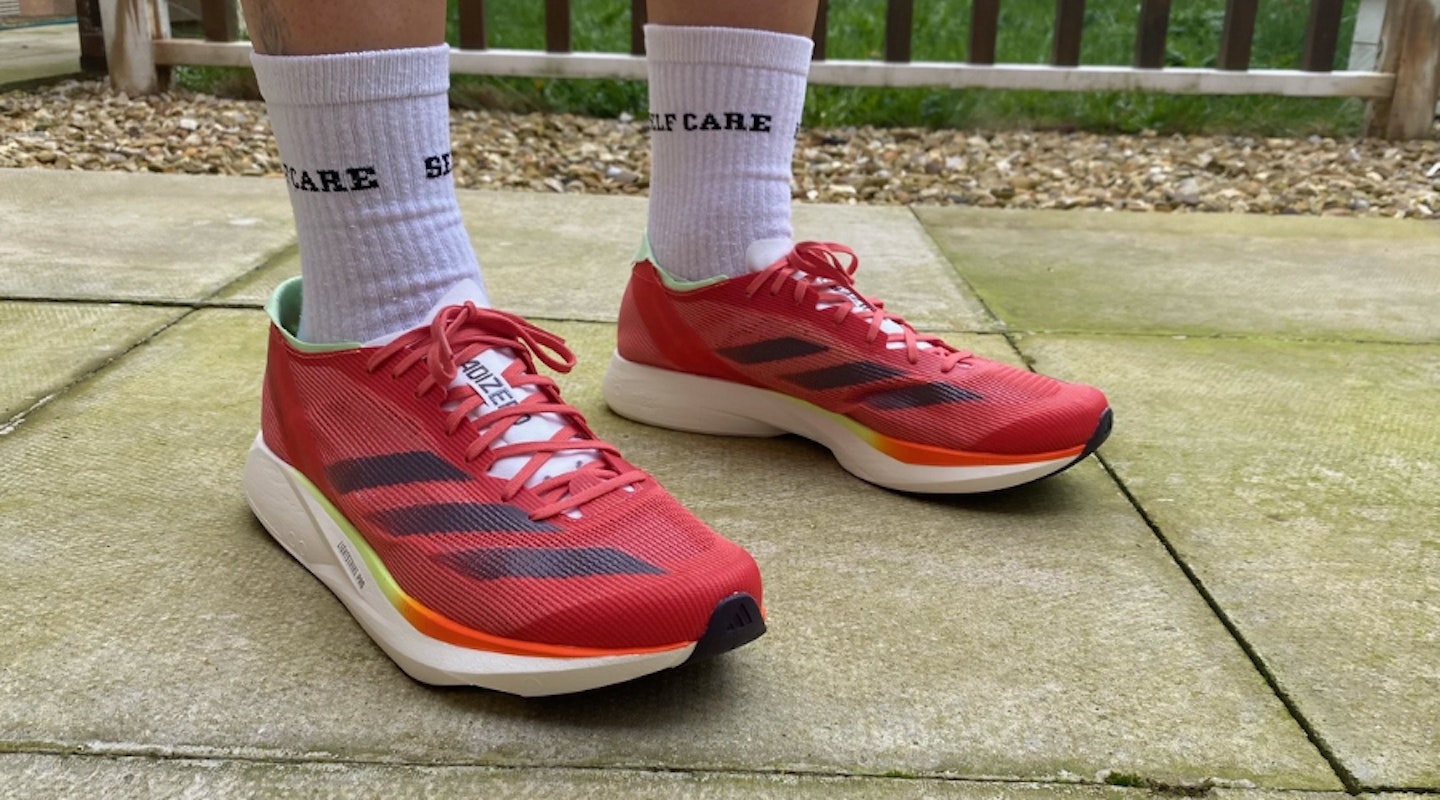 Jack Barrell - What's the Best
Jack Barrell - What's the Bestwww.adidas.co.uk
The Adizero Takumi Sen 10 Running Shoes have been meticulously crafted to boost your speed on the road. These shoes feature a responsive Lightstrike Pro midsole coupled with a durable Continental™ Rubber outsole that provides unparalleled traction in all conditions. The breathable mesh upper offers a locked-down fit, minimizing weight to maximize your race-day performance. Ideal for athletes looking to achieve fast times, these shoes combine the finest in Adidas technology with the spirit of elite marathon running.
Read our full Adidas Adizero Takumi Sen 10 review
Pros
- Firm build makes for a purposeful ride
- Super grip courtesy of Continental™ rubber
- Great build quality
- Fresh design and colour scheme
Cons
- Sizing runs small
- Not as bouncy a ride as competitors
| Sizes | UK 6-14 |
| Colours | Crystal White / Lucid Lemon / Blue Burst |
| Men/Women? | Men |
Best New Balance
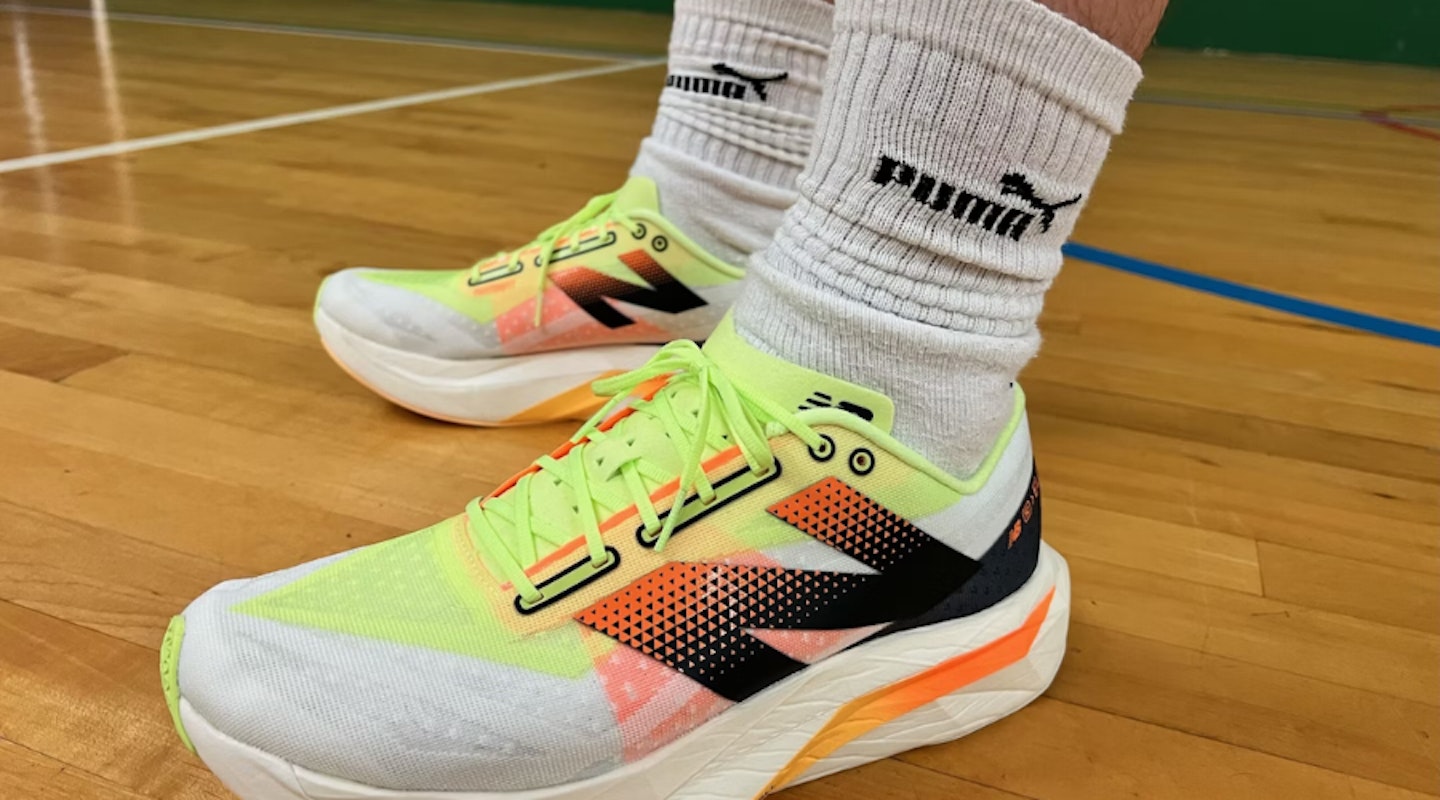 Jack Barrell - What's the Best
Jack Barrell - What's the Bestwww.newbalance.co.uk
Up your running experience with the New Balance FuelCell SuperComp Elite v4 Shoes, designed to deliver top-tier performance for serious athletes. These shoes are engineered with a cutting-edge FuelCell midsole that provides exceptional energy return and propulsion, while a strategically placed carbon fiber plate enhances efficiency with each stride. The lightweight, breathable upper ensures comfort during long runs, and the durable rubber outsole offers reliable traction on various surfaces. Perfect for competitive runners seeking to maximize their speed and endurance.
Read our full New Balance FuelCell SuperComp Elite v4 review
Pros
- Super spongy ride, gives that floating feeling
- Wonderfully supportive
- Great build quality
- Ultra-modern design
Cons
- Laces feel somewhat weak
| Sizes: | UK 6.5-12.5 |
| Colours: | White with Bleached Lime Glo and Hot Mango |
| Men/Women? | Men |
Best backed by athletes
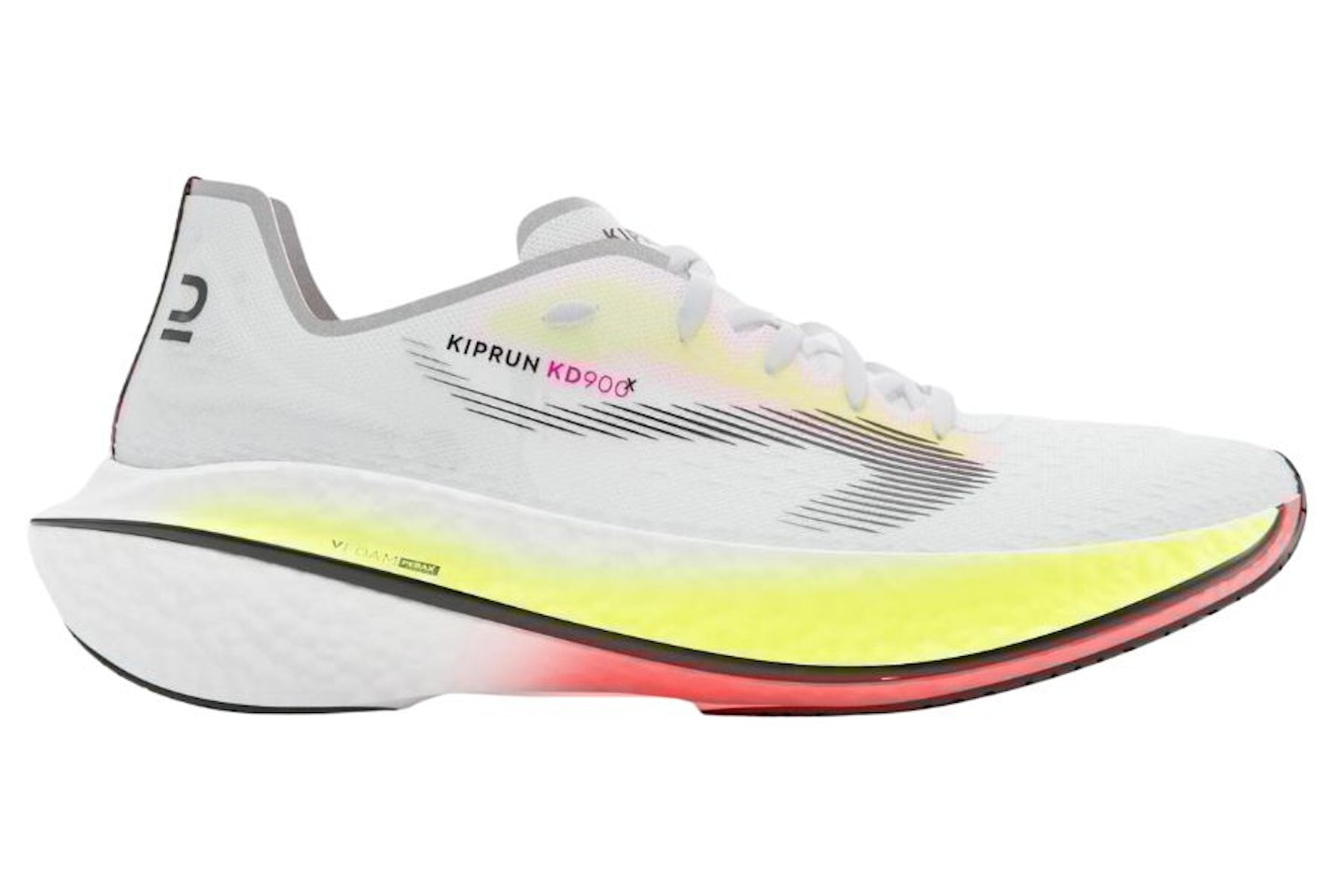
www.decathlon.co.uk
KIPRUN's KD900X shoes boast an impressive endorsement from French athlete Yoann Kowal, who sported them during the 2022 Lille semi-marathon. During this race, he not only achieved a remarkable personal best but also clocked in an astonishing time of one hour and two minutes. Following this extraordinary performance, Yoann commended these shoes for their lightweight construction and exceptional grip on various terrains, especially when tackling challenging conditions like damp surfaces and sharp hairpin bends.
Complemented by a carbon plate, these trainers are reputed to give back an astounding 75 per cent of the energy you expend, enabling you to push your fitness boundaries even further. Weighing in at a mere 225g for a size eight, KIPRUN meticulously selected the lightest materials and soles to elevate your running performance by minimizing energy consumption during workouts.
Pros
- Extremely durable: tested up to 1,500km
- Foam/carbon plate combination acts like a spring to conserve energy
- Lightweight design
Cons
- Not the best for people who really like a lot of ground feel as they run
| Sizes: | Men's UK 6.5-12, Women's UK 4-8 |
| Colours: | White, Black, Yellow, Turquoise |
| Men/Women? | Available in men's and women's |
- Customer review: "Took the plunge with a pair of "cheat shoes", and after a lot of research decided on the KIPRUN Running Shoes based on the "price per mile". I couldn't justify spending over 250 quid on a pair of shoes that might last 250 miles. Ended up getting a half size bigger to allow for wider feet. Out of the box, they are comfortable but stiff, both on the foam and in the upper. Used them for marathon training and for the event and they worked well in rain and shine. Currently just shy of 200 miles and the foam has softened nicely. Only real complaint is there is no give in the laces or uppers that you get with most trainers, so it's a balancing act to get the laces tight enough so that the feet don't slip, but not too tight that you have to stop and slacken them off."
Best for block running
Crafted with a durable synthetic upper, they provide excellent support and stability while remaining lightweight. The distinctive block-style midsole not only enhances the chunky design of the shoe but also delivers superior cushioning and comfort for a smooth and responsive ride. The Axelion has a focus on energy return and shock absorption, so the shoes empower runners to be pushed to their limits - they are an ideal companion for any track enthusiast.
Pros
- Archtec outsole follows the natural curve of the foot
- Evertrack heel piece for durability
- Contemporary chunky design
- Affordable
Cons
- Designed for track running - not for long distances
| Sizes: | UK 6-11 |
| Colours: | Black, Navy, White |
| Men/Women? | Men |
- Customer review: "Love these trainers, Puma has done a great job in making them. I was waiting for something like this from Puma for ages. Love it, light, comfortable, great for long walks and or running. I've been out wearing them the first time for and entire day. Also wore them in the rain and they remained dry on the inside to my surprise."
Best with pressure-mapped outsole
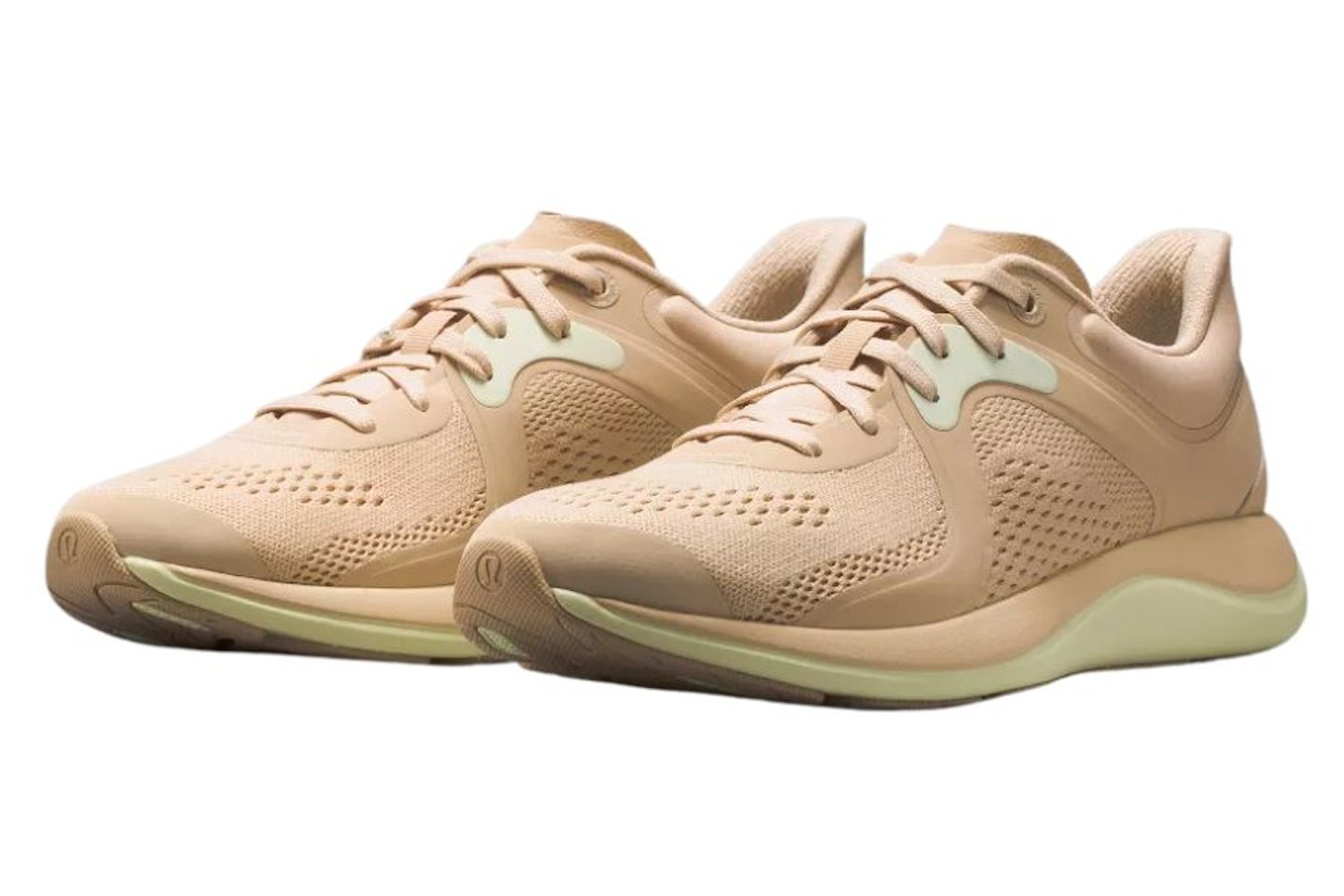
www.lululemon.co.uk
Sometimes you'll want a more multi-use trainer, which allows for a variety of sports. The Lululemon Chargefeel shoes are great for impact running but also work well as a gym trainer, great for jumping and cardio. They are also available in a large range of colours.
The breathable upper ensures maximum airflow, enhancing comfort during extended wear. The Chargefeel trainers are certainly a testament to LuLuLemon's dedication to delivering athletic footwear that meets the demands of active lifestyles without compromising on style.
Pros
- Midfoot frame to support running and training
- Pressure-mapped outsole
- Dual-density midsole for added support
Cons
- Individuals with wide feet may not find this shoe suitable, or it's advised to go up half a size
| Sizes: | UK 5-12 |
| Colours: | Grey, Ivory, Yellow, Pink, Teal |
| Men/Women? | Women |
- Customer review: "The best pair of shoes I have got in years! Comparing them to many top competitors. The second I wore them I loved them. No blisters on the first weekend despite a lot of walking and just wore them to the gym and on a run, and they are incredible!"
Best for cushioning
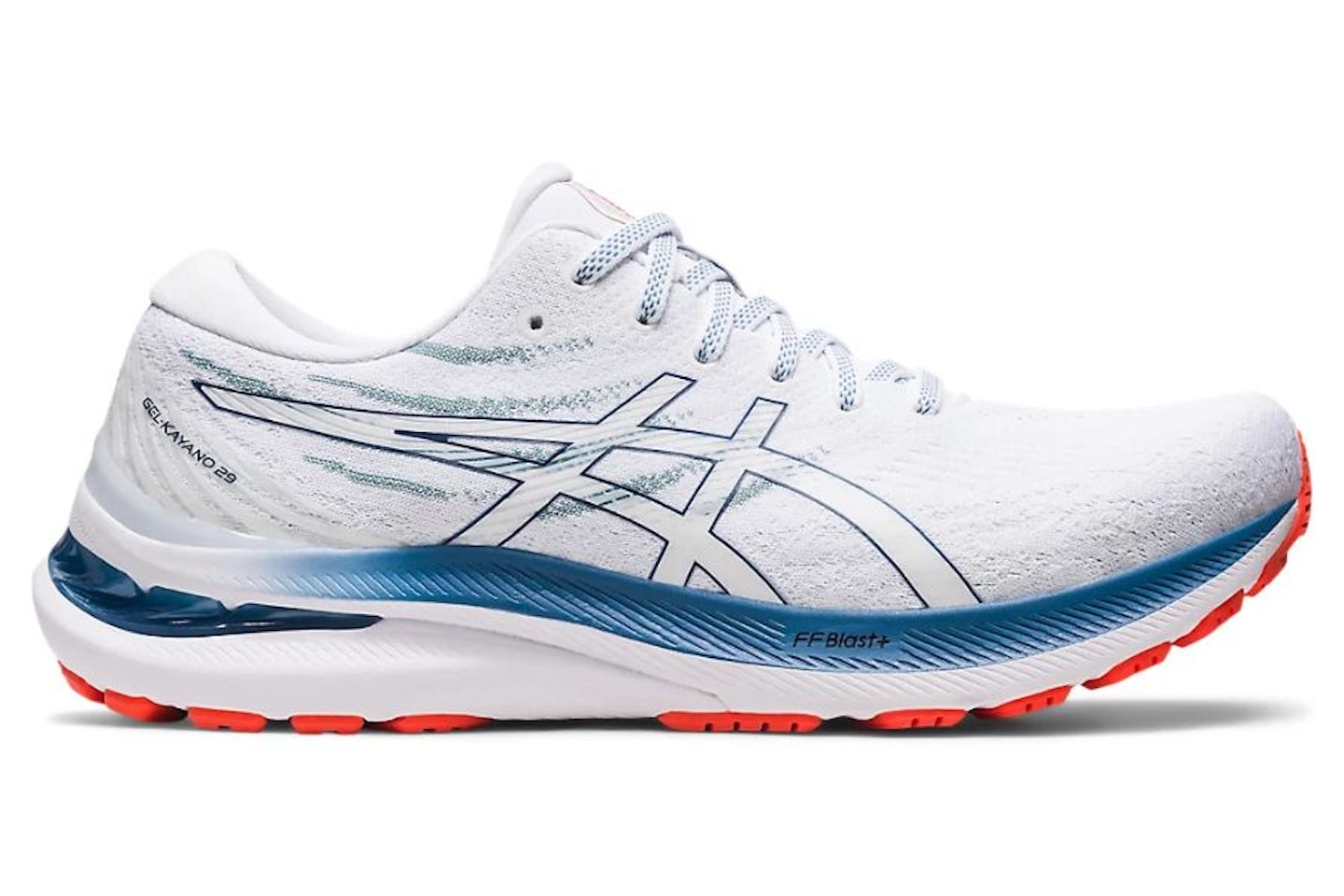
www.asics.com
If you love feeling your feet hit the pavement, then the Asics Gel Kayano 29 will ensure you do it in style. Whether you're running a marathon or around your local park, these shoes will give you the underfoot cushion you need to keep going for hours. Plus, they're really versatile because you can even use them at the gym.
Pros
- Low-profile external heel counter to ensure your foot feels fully supported
- Midsole features FF BLAST PLUS cushioning
- LITETRUSS technology on the midsole's inside angle to keep your foot from rolling inward while running
Cons
- A bit heavy
| Sizes: | UK 5-15 |
| Colours: | Various colours available including: Grey, Red, Blue, White, Black |
| Men/Women? | Men |
- Customer review: "This is my 5th pair of Asics Gel Kayano's and I would recommend for anyone who requires support whilst running. Straight out of the box, I’ve completed 2 runs and so far no issues."
10.
Nike Zoom Fly 5
Best road running shoes
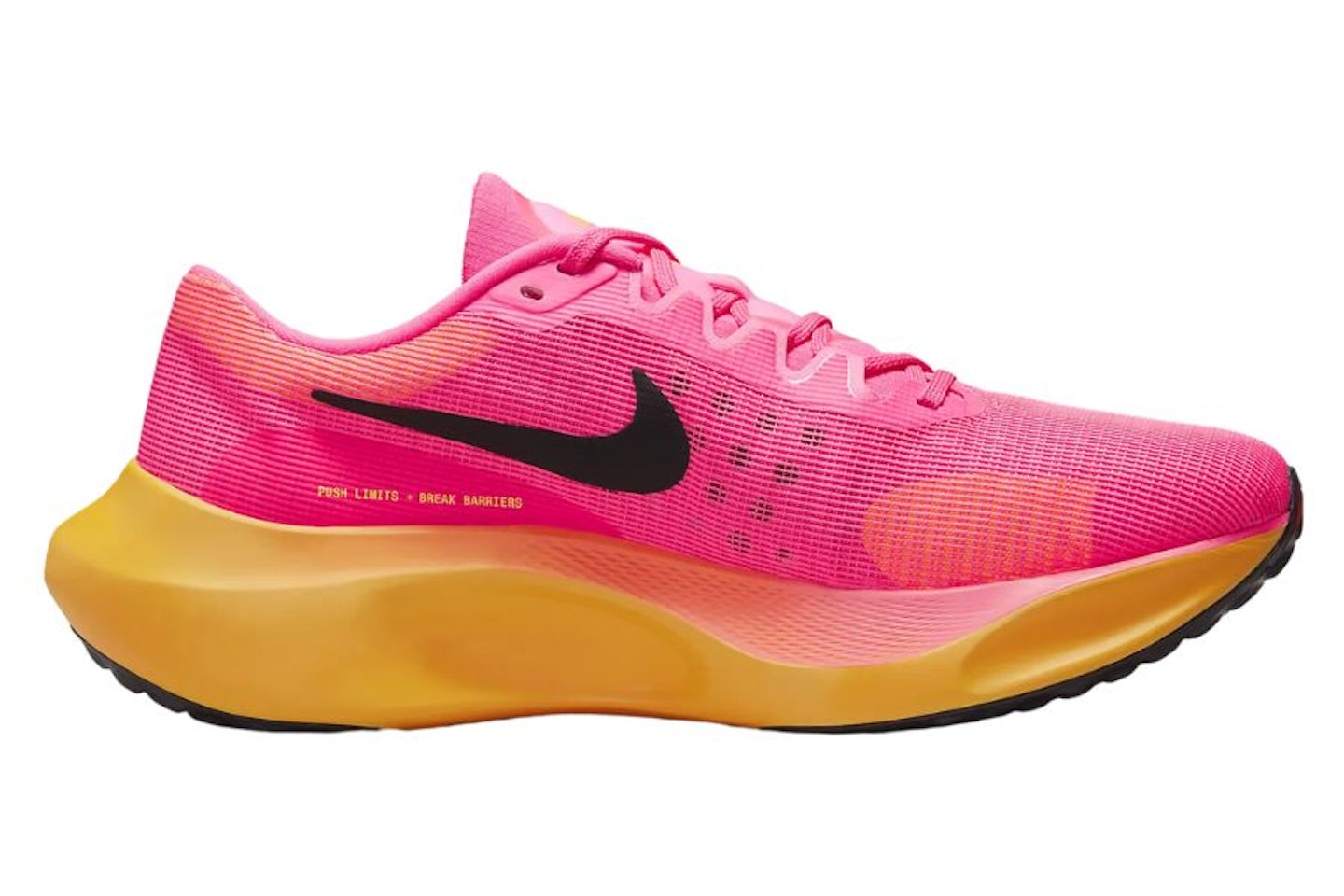
www.nike.com
Raising the bar for running shoes is the colourful Nike's Zoom Fly 5. These are so good that you can literally go from the race track to the corner shop, and they won't look out of place. If you need a cushioned fit for the road but a lightweight feel to carry them on the go, these trainers are the answer.
Pros
- ZoomX foam in the midsole creates a more responsive cushioning system
- Features a carbon-fibre plate to propel each step forward
- Upper is made from lightweight mesh for a breathable feel
Cons
- Slower than other Zoom Flies
| Sizes: | UK 5.5-14 |
| Colours: | Neon Pink, Blue, Black |
| Men/Women? | Men |
- Customer review: "Nike you made the Zoom Fly 5 perfect!!! I used to run in the Invincible 2 but felt a little unstable in that shoe. So I bought the Zoom Fly 5, and wow this shoe checks all the boxes. I can use this shoe for daily running and long runs. The carbon plate felt so good on rolling me forward and the transitions felt so smooth, and the cushioning stayed consistent all the way through my run. It's way more stable than the invincible and the lock down is perfect. No heel slip at all unlike the Invincible 3. I noticed on my running, my heart rate wasn’t that high, and also my running felt easier and faster. When it came to running up the hills, it was so much easier compared to my Invincible run. If you don’t have that much money like me you can use this shoe to daily train and race in. I’m more than confident to take this shoe on race day. I’m not a fast runner at all but this shoe gave me hope in one day becoming better overall athlete."
Best for breathability
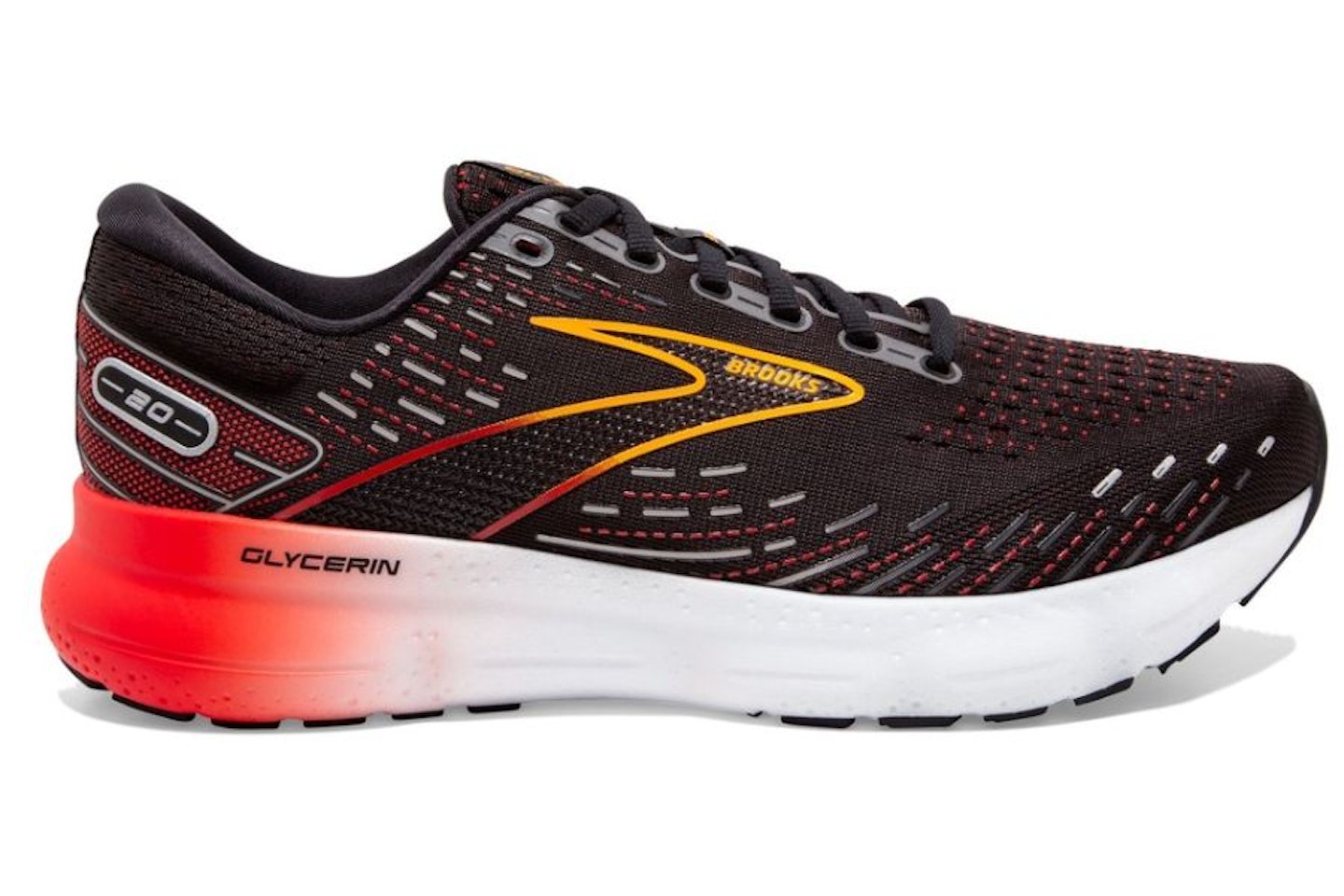
www.sportsshoes.com
Brooks is known for their comfy running trainers and super soft cushions with deep support made for roads, track and all-day comfort. This is a great choice if you're really looking for a full cushion, with its thick sole. Also designed with a mesh upper, the Glycerin 20 ensures enhanced breathability and an impeccable fit. The materials in the upper deliver an improved fit compared to previous versions of its running shoes. This is because the mesh actively facilitates the infiltration of refreshing air, effectively dissipating uncomfortable heat build-up and maintaining a cool environment for healthy and comfortable feet.
Pros
- DNA Loft v3 super soft cushioning
- Designed to give a wide platform, ensuring a smooth ride
- Padded collar and tongue
Cons
- Limited colour choice
| Sizes | UK 6-13 |
| Colours | Black |
| Men/Women? | Men |
- Customer review: "Great Brooks shoe - I'm usually logging 40+ miles per week and these are my go to trainer. Very comfortable, great cushioning, and all while still remaining pretty darn light. The Glycerin 20 is also fairly breathable, as I'm using these right now in the heat of the summer in Texas! I'd definitely buy these again."
What do I need to consider when buying the best running shoes?
Cushioning: Consider your surfaces; do you mix road with trail or is it all out mud? Look for cushioning systems that offer response and energy return. But don’t always think softer is better, as slightly harder foams can actually provide better comfort, even hard surfaces like the road. Depending on the research you read, highly cushioned shoes are better for you or equally not; it’s safe to say, cushioning levels are very personal. But generally speaking, cushioning works better for longer, slower distances.
Grip: Choose aggressive lugs for thick muddy off-roading in the mountains, but remember these can be unforgiving and slippy on harder surfaces like paths, trails and tracks. Longer lugs, around 5mm and even more, work superbly on thick mud but will wear very rapidly on the road. We like to think about traction more than grip, which allows a certain amount of natural movement rather than a rigid, unforgiving ride.
Weight: Light is not always best; longer training runs and slow, easy days can often feel better in more supportive, cushioned and, therefore, heavier shoes. Light shoes can come in around the 195g mark, while heavier shoes might top 300g. Both have a role to play. Interestingly, there’s research out there that confirms that there is indeed ‘too light’ for a road running shoe as you won’t benefit from cushioning and energy response.
Drop: This is the difference between the heel and toe; a zero (0mm) drop whatever the amount of cushioning is currently classed as the most natural option, however if you’re not used to this these will make your calves ache. Zero essentially means barefoot - shoes with that drop simulate running without shoes. A 6-8mm is a great mid-way option for trails, while traditional road shoes use a 12mm drop - these tend to be the most cushioned.
Lacing: Some shoes use traditional laces and some have a ‘quick-release’ system, they can both work equally well so it’s just a case of which fits you best and what you prefer. However, note that it is less easy to replace/repair quick-release laces if they break. More than ever before, today’s lacing systems create a performance fit - in that your feet will go through the best movement for running but with the maximum support.
Fit and comfort: Arguably the most important factor in enabling you to run faster, according to the latest research. The bottom line is, even if the shoe feels good, then chances are it is! We’re all very individual and what suits one runner, with apparently exactly the same stride, may not suit another. Generally speaking, look for a narrower fit for racing shoes, while for longer distances, consider a half size bigger to allow for foot swell over the long distance. Best of all, get your feet measured in the afternoon for a fully accurate reading (and remember, shoe sizes are a mere guide - each company varies slightly).
Uppers: Breathable is best for summer trail shoes; complete waterproofing can work on cold, dry, windy runs, but in deep puddles, mud and on wet outings, that can mean they fill up with water and hang on to it, resulting in a heavier shoe. Uppers often have a sock-like construction which allows your feet to move more naturally and effectively.
Rock plate: For trail shoes look for this technology under the forefoot and in the toe area to protect from unwanted stone bruising. It needs to be flexible and responsive but allow protection.
Toe guard: Road running shoes don’t offer this, but given hidden rocks and bits of wood can be a real danger on the trail, this piece of technology is hugely important in a trail shoe
Waterproofing: Some love it, some don’t, that dislike often related to the outdated thought that waterproofing means more weight and less flexible. Thanks to changes in the construction of uppers, this is no longer a problem, although, of course, super breathable, light summer shoes will always win when it comes to the scales. The best shoes that offer waterproofing also include outlets for drainage so that when you run through the river, any excess water will run away.
Support: Training shoes offer varying levels of support. Most of us overpronate a little meaning a slightly harder inner section on the midsole stops your knee from collapsing inwards as you run. For this reason, it’s often handy to get tested on a treadmill at a specialist running shoe shop. For most of us, we need no more than mild support or even just a neutral shoe, as some pronation is natural (without it, our knees would become damaged). But for some, this can be severe, requiring a more solid instep to the shoe. Support shoes used to be less flexible and heavier, but such is the technology used today, that’s less of an issue.
So, with all this in mind, we've hunted down the best running shoes on the market, so you can really enjoy those long runs or jogs. You can see our full selection above.
<strong>FAQs</strong>
Do I need cushioned running shoes?
There are plenty of things to consider to help determine whether cushioned running shoes are suitable for you. For example, running style can be a massive factor. If you have a neutral or under-pronation running style, which means your feet tend to roll outward when you run, cushioned running shoes can provide extra shock absorption and comfort. They can also help reduce the impact on your joints, particularly if you frequently run on hard surfaces.
Ultimately, it's essential to remember everyone's feet and running needs are different.
Is it better for running shoes to be snug or loose?
Running shoes should provide a secure and comfortable fit, which, generally speaking, means they should be snug but not overly tight. Snug-fitting shoes will help provide stability and support to your feet while running. When your feet are securely in place, you're less like to experience any movement inside the shoe, which can lead to discomfort or injury.
Shoes that are too loose can create friction and rubbing between your foot and the shoe, which could lead to blisters. A snug fit will help to reduce this friction and eliminate the risk of irritation on your feet.
Should you size down in running shoes?
Sizing down in running shoes is generally not recommended as it can lead to discomfort, pain and even injury. Running shoes that are too small may result in cramped toes, pressure points, blisters, and even toenail issues. Instead, choose the right size that allows for a thumb's width of space between your longest toe and the front of the trainer. This will ensure your toes splay, as the shoe will then accommodate the natural foot swelling during exercise and prevent your shoes from hitting the front of the shoe (especially when running downhill). Sizing down may not affect your overall performance, but it can hinder your foot health and comfort. Some brands even suggest sizing up in their running trainers.
Why should you trust us?
At What's The Best, our mission is to provide accurate and reliable reviews, ensuring our readers receive honest and transparent information about the best technology products available. Anything less would undermine our commitment to being a trusted source of unbiased product information.
Our dedicated in-house writing team comprises experts with extensive experience and a genuine passion for technology. Collectively, we have spent decades testing and writing about tech, leveraging our expertise in all our articles, advice pieces and reviews.
We maintain complete editorial independence and do not accept payment for product reviews. Our writers have full control over their content, ensuring that products are selected based solely on the needs of our readers. While we may earn commissions or other compensation from links on our website, this never affects our product choices. These links enable us to continue offering valuable consumer advice, without compromising the integrity of our reviews.
Gemma Lavers is a fitness writer for What's The Best. When she’s not travelling or writing, Gemma loves spending her weekend completing home workouts, or attending yoga, Pilates or Zumba classes.
Subscribe to the What’s The Best Newsletter to keep up to date with more of the latest reviews and recommendations from the rest of the What’s The Best team.
